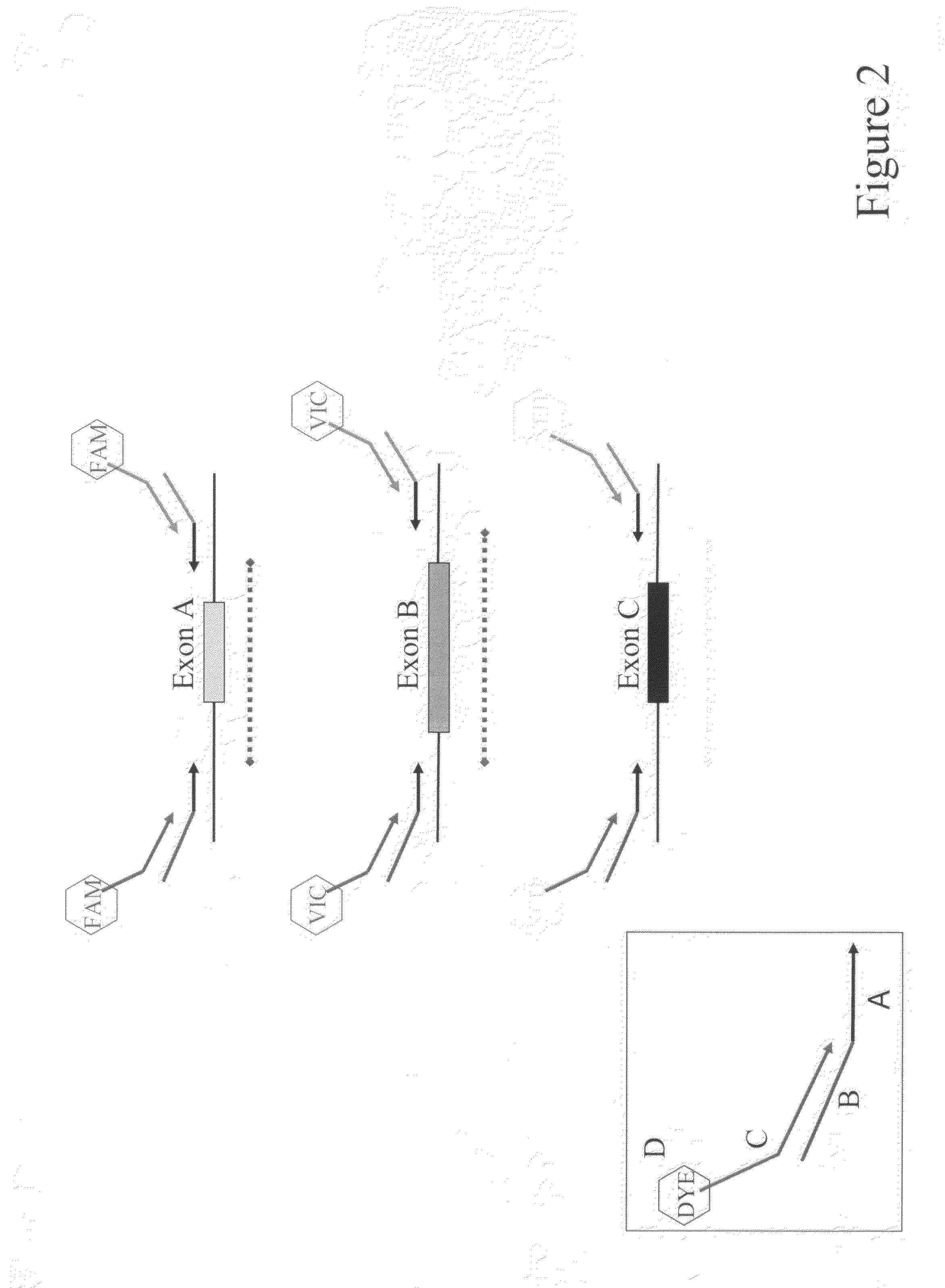Exon grouping analysis
- Summary
- Abstract
- Description
- Claims
- Application Information
AI Technical Summary
Benefits of technology
Problems solved by technology
Method used
Image
Examples
example 1
Amplification of Target DNA and the Formation of Homoduplexes and Heteroduplexes
[0097]A) Preparation of Sample DNA from Blood
[0098]DNA may be collected from blood. White blood cells collected from the peripheral blood were lysed with two washes of a 10:1 (v / v) mixture of 14 mM NH4Cl and 1 mM NaHCO3. The nuclei were resuspended in nuclei-lysis buffer (10 mM Tris, pH 8.0, 0.4M NaCl, 2 mM EDTA, 0.5% SDS, 500 ug / ml proteinase K) and incubated overnight at 37° C. Samples were then extracted with a one-fourth volume of saturated NaCl and the DNA was precipitated in ethanol. The DNA was then washed with 70% ethanol, dried, and dissolved in TE buffer (10 mM Tris-HCl, pH 7.5, 1 mM EDTA.). Ninety-five DNA samples from breast cancer patients and controls were obtained at DFCI under IRB approved protocols.
[0099]Primers for 88 PCR fragments (34 BRCA1 and 54 BRCA2) were chosen to span the coding region of BRCA1 and BRCA2. The PCR fragments ranged from 232 to 558 base pairs in BRCA1 and 194 to 567...
example 2
Analysis of Amplified DNA by Electrophoresis and DNA Sequencing
Multiplexed PCR Lanes
[0104]The 5 multiplexed PCR lanes consist of 6 FAM-labeled primers, 6 VIC-labeled primers and 6 NED-labeled primers. Following the heteroduplex formation, primers labeled in the same color from each patient are mixed together in 25 μL of PCR buffer (0.05M Tris, 0.05M KCL, pH 8.0). These multiplexed PCR fragments are then combined in a 3 FAM: 4 VIC: 6 NED ratio. The approximate final dilutions of PCR product are as follows: 1:100 FAM; 1:70 VIC; 1:45 NED. Finally the FAM, VIC, NED multiplexed mixture is combined in a 1:1 ratio with our ROX labeled size standard.
Scanning of Multiplexed PCR Products
[0105]The 0.2-mm thick gel was prepared with 1.13×MDE Gel Solution (Cambrex), 22.5% Formamide (Fisher Scientific), 15% Ethylene Glycol (Fisher Scientific), 0.05% ammonium persulfate (Fisher Scientific) and 0.005% N,N,N′,N′tetramethylethylenediamine (Fisher Scientific) in 0.6×TTE (44.4 mM Tris / 14.25 mM Taurine / ...
example 3
Validation of Exon Grouping Analysis
[0113]Exon Grouping Analysis (EGAN) on a library of 216 distinct test amplicons were tested and validated. For testing and evaluation, amplicons of different characteristics were tested. These characteristics includes size, GC richness (which can be expressed as % GC, % pyrimidines or % purines), and the nature of mutation. The nature of mutation may be the change of any one base of a nucleic acid sequence to any other base. A total of 12 types of mutations, such as A to G, A to C, A to T, G to A, G to T, G to C, C to G, C to T, C to A, or T to A, T to G, and T to C, can occur. Of course, point mutations that do not alter sequence, such as A to A, G to G, C to C and T to T are not detected. These parameters are plotted in FIG. 8A. In FIG. 8A, the amplicons range in size from 200 to 700 base pairs in the context of 40%, 50% and 60% GC richness. Each possible combination of GC richness and basepair length has a point mutation introduced where a base...
PUM
| Property | Measurement | Unit |
|---|---|---|
| Temperature | aaaaa | aaaaa |
| Fraction | aaaaa | aaaaa |
| Fraction | aaaaa | aaaaa |
Abstract
Description
Claims
Application Information
 Login to View More
Login to View More - R&D
- Intellectual Property
- Life Sciences
- Materials
- Tech Scout
- Unparalleled Data Quality
- Higher Quality Content
- 60% Fewer Hallucinations
Browse by: Latest US Patents, China's latest patents, Technical Efficacy Thesaurus, Application Domain, Technology Topic, Popular Technical Reports.
© 2025 PatSnap. All rights reserved.Legal|Privacy policy|Modern Slavery Act Transparency Statement|Sitemap|About US| Contact US: help@patsnap.com



